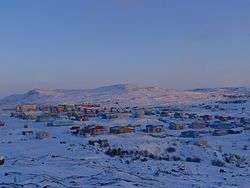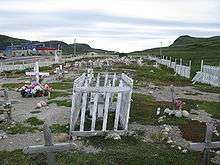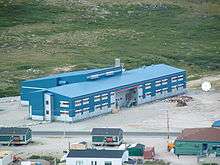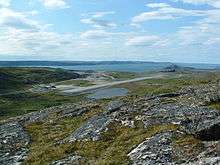Kangiqsualujjuaq
Kangiqsualujjuaq (/kænˌdʒɪksuˈæluːdʒuæk/)[4] is an Inuit village located at the mouth of the George River on the east coast of Ungava Bay in Nunavik, Quebec, Canada. Its population was 874 as of the 2011 census.
Kangiqsualujjuaq ᑲᖏᕐᓱᐊᓗᑦᔪᐊᖅ | |
|---|---|
Northern village municipality | |
 | |
 Kangiqsualujjuaq | |
| Coordinates: 58°41′N 65°57′W[1] | |
| Country | Canada |
| Province | Quebec |
| Region | Nord-du-Québec |
| TE | Kativik |
| Constituted | February 2, 1980 |
| Government | |
| • Mayor | Hilda Snowball |
| • Federal riding | Abitibi—Baie-James—Nunavik—Eeyou |
| • Prov. riding | Ungava |
| Area | |
| • Total | 35.50 km2 (13.71 sq mi) |
| • Land | 35.05 km2 (13.53 sq mi) |
| Population (2011)[3] | |
| • Total | 874 |
| • Density | 24.9/km2 (64/sq mi) |
| • Change (2006–11) | |
| • Dwellings | 191 |
| Time zone | UTC−5 (EST) |
| • Summer (DST) | UTC−4 (EDT) |
| Postal code(s) | J0M 1N0 |
| Area code(s) | 819 |
| Website | www |
Names
The settlement's original name Fort Severight honoured John Severight, a North West Company man who had headed Fort Coulonge during McLean's time there. After its reëstablishment, it was variously known from its location as Fort George, George's River,[5] George River, George River Post, and Fort George River. It was also sometimes known as Port-Nouveau-Québec (French for "Port New Quebec").
The name "Kangiqsualujjuaq" (Inuktitut: ᑲᖏᖅᓱᐊᓗᔾᔪᐊᖅ) is Inuktitut for "the very large bay". It is also sometimes spelled "Kangirsualujjuaq" (ᑲᖏᕐᓱᐊᓗᔾᔪᐊᖅ).
Geography
Kangiqsualujjuaq is located 1,688 km (1,049 mi) to the northeast of Montreal. Enveloped by mountains, the township is framed by picturesque surroundings and its elevated position affords unobstructed views of the George River. The town itself is laid out on a grid pattern over levelled-ground, with two unsealed roads leading a few kilometres beyond the mountain ridges at either end of the village. Amidst rocky outcrops and stone way-finding markers (Inukshuk), the village landscape is dotted with stands of stunted trees and prostrate groundcover that clings perilously to the rugged granite terrain. In low-lying areas, the ground is covered by thick carpets of moss and lichen.
History

John McLean established Fort Severight for the Hudson's Bay Company in 1838.[5] It was a bit south of the present-day town, at 58°31′43.03″N 65°53′34.58″W (now marked as Illutaliviniq on topographic maps). It served as a salmon and seal fishery, supplying Fort Chimo to the west and Fort Trial and Fort Nascopie to the south. It was abandoned in 1842[5] after Fort Chimo turned out to be an unprofitable station and a path was found to supply Nascopie from Fort Smith to the southeast. The Inuit of the area never settled around the post, preferring to live along the coast in summer and setting their camps about 50 km (31 mi) inland in winter.
The site was taken up again in September 1876, mostly to capture the local indigenous peoples' trade which had been going to the Moravians. The new buildings were built from the old. The site abandoned again in the summer of 1878 before reopening again in 1883. It again functioned as a salmon and seal fishery for Fort Chimo, although it carried on some local trading until that was removed to Port Burwell in 1917. HBC shuttered its office in June 1952.[5]
In 1959, local Inuit established, on their own initiative, the first co-operative in Northern Quebec for the purpose of marketing Arctic char. Construction of the village began in 1962 and Inuit began to settle there permanently. In 1963 a school, a co-operative store, and government buildings were built. In 1980, Kangiqsualujjuaq was legally established as a municipality.
The community was stricken by an avalanche in the early morning of January 1, 1999, which destroyed the Satuumavik School gymnasium during New Year celebrations, killing nine.[6] Another 25 people were injured, 12 of them seriously enough to have to be airlifted 1,500 km (930 mi) to Montreal for treatment. Some speculated that it may have been triggered by lively dancing at the party.[7] The school was rebuilt on the new, safer location and renamed to Ulluriaq School.
Government

The police services are provided by the Kativik Regional Police Force.[8] The Kativik School Board formerly operated the Ulluriaq School, previously the Satuumavik School.[9]
Economy
Industries in Kangiqsualujjuaq include hunting of caribou, seal and beluga whale, Arctic char fishing, and the production of Inuit art. The town is also the main terminus of the George River canoeing expeditions (e.g. one of Chewonki Foundation's canoe trips).[8]
Transportation
.jpg)
The town is served by the small Kangiqsualujjuaq Airport.[8] Access is usually by plane, although Kangiqsualujjuamiut occasionally travel to Kuujjuaq in winter by snowmobile and in summer by boat, a journey of approximately 160 km (99 mi) to the southwest. Journeys across the Torngat Mountains by snowmobile to the Labrador settlements Nain and Nachvak are rarely embarked upon these days, but were commonplace when dog teams were used. Cargo ships from Montreal deliver cumbersome supplies and equipment to the community every summer.
Notable people
Inuit elders from Kangiqsualujjuaq include:
- Noah Angnatuk
- George Annanack
- Johnny Sam Annanack
- Maggie Annanack (Elsie Imaq)
- Sarah Annanack
- Willie Emudluk
- Benjamin Jararuse
- Tivi Etok
- Willie Etok
Explorers and missionaries who have visited the town include: Explorers and Missionaries
The town is also the home of Donat Savoie.
Images
| Wikimedia Commons has media related to Kangiqsualujjuaq. |
 Kangiqsualujjuaq Hotel
Kangiqsualujjuaq Hotel.jpg) Streets of Kangiqsualujjuaq
Streets of Kangiqsualujjuaq Kangiqsualujjuaq at night
Kangiqsualujjuaq at night Kangiqsualujjuaq
Kangiqsualujjuaq
 Inukshuk
Inukshuk Kangiqsualujjuaq hockey rink
Kangiqsualujjuaq hockey rink
References
- Reference number 97009 of the Commission de toponymie du Québec (in French)
- Geographic code 99090 in the official Répertoire des municipalités (in French)
- "(Code 2499090) Census Profile". 2011 census. Statistics Canada. 2012.
- The Canadian Press (2017), The Canadian Press Stylebook (18th ed.), Toronto: The Canadian Press
- "George's River", Official site, Archives of Manitoba.
- "Avalanche!". CBC. Retrieved 2010-02-10.
- "Avalanche in Quebec". The Canadian Encyclopedia. Retrieved 2010-02-10.
- KRPF. "General Information". Home. Retrieved 2017-07-03.
- "Ulluriaq Home Page." Kativik School Board. May 28, 2001. Retrieved on September 23, 2017.
External links
- Kativik Regional Government
- Nunavik tourism - Kangiqsualujjuaq website
- Kangiqsualujjuaq, Quebec Statistics Canada
- Ulluriaq School, Kangiqsualujjuaq
- Inuit Knowledge and Perceptions of the Land-Water Interface, a comprehensive study of the Kangiqsualujjuaq people and their knowledge and perceptions of their homelands by Scott Heyes (2007)
- Schooling the North